

Positively White Cube Revisited. Simon Sheikh Few essays have garnered as much immediate response as Brian O’Doherty’s “Inside the White Cube,” originally published as a series of three articles in Artforum in 1976, and subsequently collected in a book of the same name.1 According to myth, the issues of Artforum containing O’Doherty’s texts sold out very quickly, and as he himself has remarked, many artists he spoke to at the time told him that they themselves had been thinking about writing something similar.
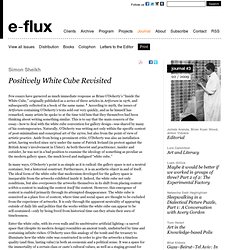
This is to say that the main concern of the essay—how to deal with the white cube convention for gallery design—was shared by many of his contemporaries. Naturally, O’Doherty was writing not only within the specific context of post-minimalism and conceptual art of the 1970s, but also from the point of view of artistic practice. Cover of Inside the White Cube, published by University of California Press, 1999. About Manifest.AR. ManifestAR is an international artists’ collective working with emergent forms of augmented reality as interventionist public art.

The group sees this medium as a way of transforming public space and institutions by installing virtual objects, which respond to and overlay the configuration of located physical meaning. Utilizing this technology as artwork is an entirely new proposition and explores all that we know and experience as the mixture of the real and the hyper-real. Physically, nothing changes, the audience can simply download and launch an Augmented Reality Browser app on their iPhone or Android and aim the devices’ camera to view the world around them. The application uses geolocation, marker tracking and image recognition software to superimpose computer generated three-dimensional art objects, enabling the public to see the work integrated into the physical location as if it existed in the real world. Augmented Reality: AR uninvited at MOMA NYC. *To the alarm and surprise of practically everybody including myself, I’m pretty sure that I will be uninvitedly attending this uninvited AR event this weekend in New York.
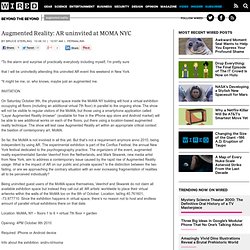
*It might be me, or, who knows, maybe just an augmented me. On Saturday October 9th, the physical space inside the MoMA NY building will host a virtual exhibition occupying all floors (including an additional virtual 7th floor) in parallel to the ongoing show. The show will not be visible to regular visitors of the MoMA, but those using a smartphone application called “Layar Augmented Reality browser” (available for free in the iPhone app store and Android market) will be able to see additional works on each of the floors, put there using a location-based augmented reality technique. The show will test case Augmented Reality art within an appropriate critical context: the bastion of contemporary art, MoMA.
Etc_WhiteCubeAugmented_p052-57_8.5x11inch - etc_WhiteCubeAugmented_2012-10.pdf. Creativity Bytes: A Brief Guide To Augmented Reality Art Exhibits. Erkki_Huhtamo-Elements_of_Screenology.pdf. Video archive » mcluhan2011.eu. Archives from 27 – 29 May 2011 (Berlin) You can view the video documents of the entire conference below.

There are four short videos of introductions by the Canadian Ambassador Peter M Boehm; the conference curator, Dieter Daniels; the McLuhan in Europe 2011 programme initiator, Stephen Kovats; and the conference moderator, Christopher Salter. Essays : An Archeology of a Computer Screen. Big Red & Shiny: Art At The Cusp: Manifest.AR. There can be no art revolution that is separate from a science revolution, a political revolution, an education revolution, a drug revolution, a sex revolution, or a personal revolution . . .

—Lee Lozano, Statement for Art Worker’s Coalition, 1969. If you listen to certain voices you will be told that art is irrelevant; that it is not required to succeed in life; that there are better, more profitable things to do. If you are involved in any sociopolitical issue—which means you have a pulse—you know the lie of this alleged wisdom. Lev Manovich, The poetics of Augmented Space-2006.pdf.
Museum Identity Ltd - high-quality conferences, study days, publications, for professionals. British Museum - Augmented Reality: Beyond the Hype by Shelley Mannion, Digital Learning Programmes Manager, The British Museum Augmented Reality (AR) is a hot topic in the museum community.
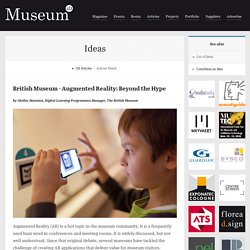
It is a frequently used buzz word in conferences and meeting rooms. Augmented Reality projects, articles & talks by Helen Papagiannis. Augmented Stories. Lev Manovich: TEACHING. Students presenting their projects in my class (analysis and visualization of large media data sets) on a HiperSpace scalable visualization system.

I am a Professor at The Graduate Center, CUNY (City University of New York). An Explorer’s Guide to Augmented Reality’s Creative Future. An Explorer’s Guide to Augmented Reality’s Creative Future It was a great honour to speak at the Ontario Augmented Reality Network (OARN) 2012 conference today alongside sci-fi guru & contributing editor of Wired Magazine Bruce Sterling and Gene Becker from Samsung.

The Augmented Cinema Film Festival. Apple's Patent on the Pinch-and-Zoom Falls. Thomas Hirschhorn, Bootleg extract from Touching Reality.
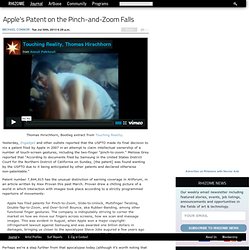
Yesterday, Engadget and other outlets reported that the USPTO made its final decision to nix a patent filed by Apple in 2007 in an attempt to claim intellectual ownership of a number of touch-screen gestures, including the two-finger "pinch-to-zoom. " Melissa Grey reported that "According to documents filed by Samsung in the United States District Court for the Northern District of California on Sunday, [the patent] was found wanting by the USPTO due to it being anticipated by other patents and declared otherwise non-patentable. " Patent number 7,844,915 has the unusual distinction of earning coverage in Artforum, in an article written by Alex Provan this past March. Digital-divide-contemporary-art-and-new-media-artforum-com-by-claire-bishop-sept-2012.pdf. (General indifference towards) The Digital Divide. Emily Jacir – Mateiral for a Film How might we explain the ascent, pervasiveness and popular appeal of digital art?
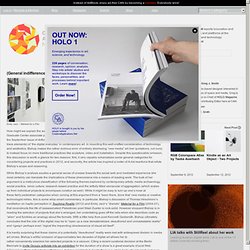
This is not the question that CUNY Graduate Center associate professor Claire Bishop chose to answer in her recent “Digital Divide” article, published in the September issue of Artforum. Hito Steyerl: The Wretched of the Screen (2012. 23 October 2012, dusan. Corporate Rule of Cyberspace. Part of the global push towards the privatization of the "general intellect" is the recent trend in the organization of cyberspace towards so-called "cloud computing. " Little more than a decade ago, a computer was a big box on one's desk, and downloading was done with floppy disks and USB sticks. Today, we no longer need such cumbersome individual computers, since cloud computing is Internet-based, i.e., software and information are provided to computers or smartphones on demand, in the guise of web-based tools or applications that users can access and use through browsers as if they were programs installed on their own computer.
In this way, we can access information from wherever we are in the world, on any computer, with smartphones literally putting this access into our pocket. Rhizome. Art In Your Pocket. Image: Lia, PhiLia 01, 2009 As the niche genre of software art expands beyond the web and into mobile devices, media artists are finding ways to integrate their work into a new form of business model. Instead of giving away your work for free on the web, Apple's iPhone and iTouch devices provide an ample platform for distribution (through the Apple App Store) and hardware support for novel ways to experience screen-based work.
Since the App Store was unveiled last year, the over 30,000 available applications have taken the form of everything from mock cigarette lighters ( Zippo's App ) to mobile flutes ( Ocarina ) to utilitarian apps such as Urban Spoon (Restaurant finder) to social networking in physical spaces ( Loopt ). Noticing this trend, media artists who once found their free and limitless distribution platform through a desktop computer browser are now turning their attention and creative efforts toward the mobile space of the iPhone.
Image: Steph Thirion, Eliss, 2009. Decoding Your iPad's Smudges. US_layout_01022010.pdf. Mobile Audience. Amir Baradaran. The Artist is Prescient: Relational Aesthetics and Augmented Reality. Amir Baradaran, "FutARism Performance," 2011. Benrimon Contemporary (NYC). Courtesy the artist. This entry takes up where I left off last December, when I documented my encounter with electronics artist Rafael Lozano-Hemmer who lectured at the High Museum of Art (Atlanta) about art that engages in “the realm of social interaction and content.” Since then, I successfully completed my first year in a digital media Ph.D program and I continue to cover emerging contemporary artistic practices in the social realm.
Writing posts about socially-engaged and paradoxical art in popular culture led me into the topic of mobile augmented reality (defined below). 2012: ZKM appartaward. Stanza touchscreen artwork editions. Digital generative and interactive artworks for sale by artist Stanza. Interactive +generative systems. 1997 - 2007. Exhibition: generative artworks. Images from Late at Tate Britain event: 2007 (Shows touch screen artwork in a plynth) Stanza Images from exhibition at Venice Biennale 2007. Shown at New Forest Pavilion, 52nd international Art Exhibition - la Biennale di Venezia. Exhibition. Blast Theory. Julian Oliver - Words. 34 NORTH 118 WEST. Jonah Brucker-Cohen: Interactive Networked Projects. Frances Stark. MPG: Mobile Performance Group. Networked_Performance. Mobile Feelings. Laura beloff, media art, art, art& science, media, art & technology, artist.
François Quévillon. Touching Reality, Thomas Hirschhorn. Pourquoi est-il important — aujourd’hui — de montrer et regarder des images de corps humains détruits ? Thomas Hirschhorn Je vais tenter d’expliquer en huit points pourquoi il est important aujourd’hui de regarder des images de corps humains détruits, comme celles que j’ai utilisées et intégrées dans mes œuvres telles que Superficial Engagement (2006), The Incommensurable Banner (2008), Ur-Collage (2008), Crystal of Resistance (2011) ou Touching Reality (2012). 1. Provenance Les images de corps humains détruits sont faites par des non-photographes. La plupart d’entre elles ont été prises par des témoins, des passants, des soldats, par des agents de sécurité ou de police, des sauveteurs ou des secouristes. 2.
Les images de corps humains détruits sont importantes du fait de leur redondance. 3. Aujourd’hui, dans les journaux, les magazines et dans les journaux télévisés, nous voyons très peu d’images de corps détruits, parce qu’elles sont très rarement montrées. 4. Thomas Hirschhorn Touching Reality on Artabase. Saturday 05 October 2013 to Saturday 30 November 2013. Swiss Pavilion at Venice Biennale 2011: Interview with Thomas Hirschhorn. Expanded Cinema as Expanded Reality. Jeffrey-shaw.net. Medien Kunst Netz. School of Creative Media. Janet Cardiff & George Bures Miller. The Alter Bahnhof Video Walk.
Production Manager Christoph Platz. Cardiff, Janet: Biografie. Theory of the Derive (Debord) Spectacle - The_Society _Of _The _Spectacle.pdf. The Society of the Spectacle (1) (Debord) Screens of Navigation: From Taking a Ride to Making the Ride – Nanna Verhoeff. Janet Cardiff by Atom Egoyan. T E R I . R U E B. Bibliothek Uni Leipzig. AAAARG.ORG.